Last Updated on November 21, 2025 by Caesar Fikson
Casino chip values and colors form the universal language of the gaming floor. Whether you’re stacking poker chips, placing blackjack bets, or sliding high-value baccarat plaques across the felt, knowing chip denominations is essential. From $1 white chips in Las Vegas to €5,000 orange chips in Monte Carlo and HKD $25,000 high-roller tokens in Macau, these color-coded discs streamline play, prevent confusion, and set the tone at every table.
In this guide, we’ll break down standard chip colors, explore international variations, and share tips for recognizing and using the right chips in any casino worldwide.
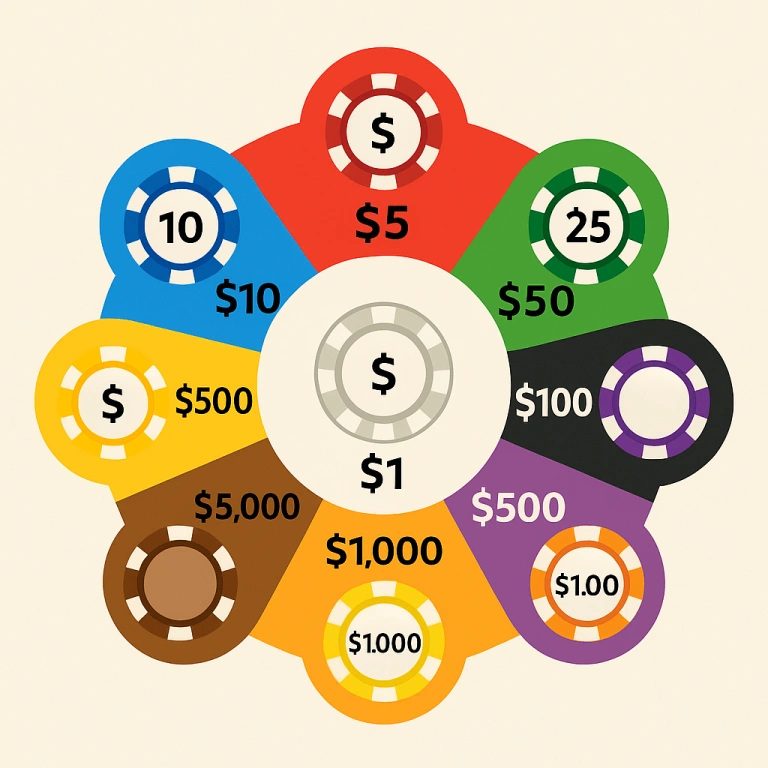
🎯 Casino Chip Colors & Values Cheetsheet – Worldwide Quick Reference
| 🎨 Color | 🇺🇸 Las Vegas (USD) | 🇲🇨 Monte Carlo (EUR) | 🇲🇴 Macau (HKD/MOP) | 💡 Notes |
|---|---|---|---|---|
| ⚪ White | $1 | €5–€10 | $10–$20 | Common table minimums, small blinds |
| 🔴 Red | $5 | €25 | $100 | Standard roulette & blackjack bets |
| 🔵 Blue | $10 | €50 | $500 | Mid-tier stakes, less common in cash games |
| 🟢 Green | $25 | €100 | $1,000 | Mid-high stakes poker, double downs |
| ⚫ Black | $100 | €250–€500 | $5,000 | High-limit floor action |
| 💜 Purple | $500 | €1,000 | $10,000 | Tournament & VIP room play |
| 🟧 Orange | $1,000 | €5,000 | $25,000 | Baccarat & high-stakes tournament chips |
| 🟤 Brown/Burgundy | $5,000 | €10,000+ | $50,000+ | Ultra-high-roller, plaques often used |
So, let’s dive right in and unravel the mysteries of casino chip value and color, which is especially important in environments like Texas Hold ’em poker, where chip stacks can determine the course of a hand.
Standard U.S. Casino Chip Colors & Values
In most North American casinos, the color-coding is fairly standardized. While there are occasional exceptions, these are the most common denominations you’ll encounter:
| 🎨 Color | 💵 Value | Notes |
|---|---|---|
| ⚪ White | $1 | Often called bones in old-school poker slang |
| 🔴 Red | $5 | Staple in blackjack & roulette |
| 🟢 Green | $25 | Common for double-downs or larger raises |
| ⚫ Black | $100 | “The Benjamin” of the chip world |
| 💜 Purple | $500 | High-stakes rooms & tournaments |
| 🟧 Orange/Maroon | $1,000 | Sometimes gray in certain casinos |
| 🟤 Brown | $5,000 | Usually in high-roller or VIP sections |
💡 Insider tip: Even in the U.S., some tribal or private casinos tweak colors for branding, so don’t assume — check the table placard.
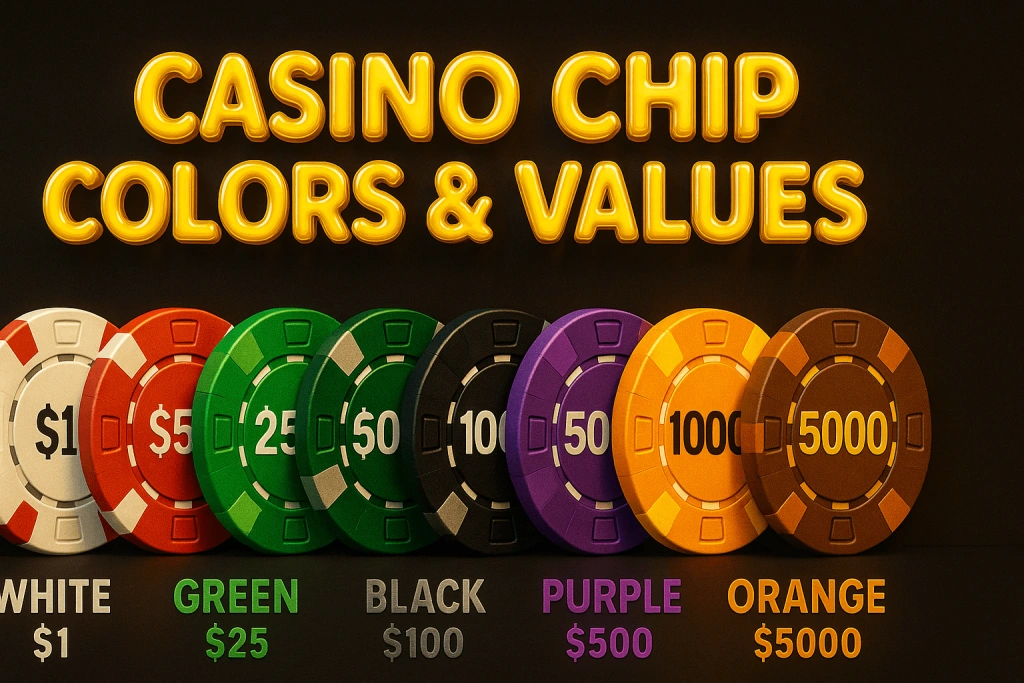
Step into any casino — from the Wynn Las Vegas to the poker room at Casino de Monte-Carlo — and the first thing you’ll notice is the rainbow spread of chips on the table. Those colors aren’t just for show; they’re the casino’s universal language. Misreading them can cost you a pot, a hand, or even a night’s bankroll. In poker, blackjack, and baccarat, the ability to instantly assign value to a color is as critical as reading your opponent’s tells.
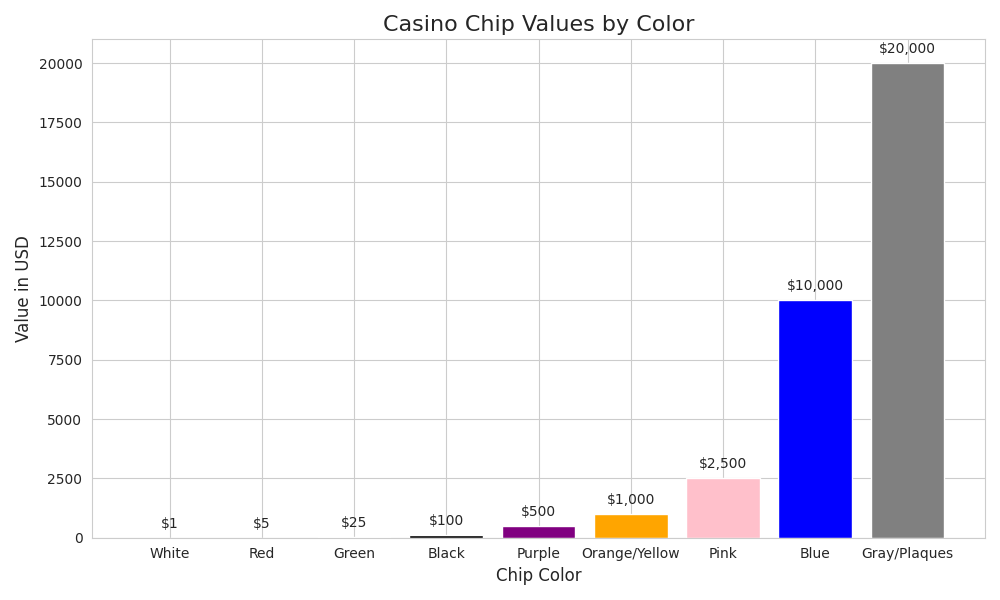
Knowing these basics can make the difference between a smooth and enjoyable gaming experience and one filled with confusion and costly mistakes. When you understand the value behind each chip color, you immediately gain an edge, not just in recognizing stakes but also in reading the dynamics of the table.
Extended Poker Chip Colors for Tournaments
Tournament sets often expand beyond the standard cash game palette to make big stacks easier to read from across the table.
| 🎨 Color | 💵 Value | Typical Use |
|---|---|---|
| 🟨 Yellow | $2 or $1,000 | Rare in cash games; often high-denom in tourneys |
| 🔵 Blue | $10 or $2,000 | Mid-range tournament bets |
| 🩶 Gray | $20 | Rare in live casinos, common in home games |
| 💖 Pink | $250 | Seen in higher-stakes poker |
| 🔶 Light Blue | $2,000 | Tournament blind jumps |
| 🟤 Brown/Burgundy | $5,000+ | Deep-stack or VIP events |
How Colors Change Worldwide
Chip colors may look familiar, but step into an international casino and the values can shift dramatically.
| 🌍 Location | ⚪ White | 🔴 Red | 🔵 Blue | 🟢 Green | ⚫ Black | 💜 Purple | 🟧 Orange | 🟤 Brown |
|---|---|---|---|---|---|---|---|---|
| Las Vegas | $1 | $5 | $10 | $25 | $100 | $500 | $1,000 | $5,000 |
| Monte Carlo | €5–€10 | €25 | €50 | €100 | €250–€500 | €1,000 | €5,000 | €10,000+ |
| Macau | HKD $10–$20 | HKD $100 | HKD $500 | HKD $1,000 | HKD $5,000 | HKD $10,000 | HKD $25,000 | HKD $50,000+ |
✈️ Travel tip: In Macau, a single orange chip can be worth more than a luxury car. Always confirm chip values before betting in a new jurisdiction.
Iconic Chip Denominations Explained
⚪ White – $1
The workhorse of the casino. Used for small blinds, table minimums, and low-limit bets. In older gambling halls, they were bone or ivory-colored clay.
🔴 Red – $5
Ubiquitous in roulette and blackjack. Often the “standard” bet for casual players in Vegas.
🟢 Green – $25
The gateway to bigger pots. In poker, often used for opening raises in mid-stakes cash games.
⚫ Black – $100
The psychological milestone. Throwing down a black chip changes table energy instantly.
💜 Purple – $500
High-limit rooms love these — not common on the main floor. In some East Coast casinos, nicknamed “Barneys.”
🟧 Orange – $1,000
Big tournament chip or high-roller play. In Europe, sometimes a pastel yellow instead.
🟤 Brown – $5,000
Seen in nosebleed-limit games and final tournament tables.
A stack of blacks hits felt and the table goes quiet. Funny how color sets the tone: red feels casual, green gets respect, black changes the air.
And purple?
Different conversation.
At NOWG, I’ve spent enough nights sanity-checking chip racks and rulebooks to know two things: there’s a de facto color map most rooms follow, and there are just enough exceptions to burn a new dealer—or a new player. This is the practical guide I wish every pit and content team kept pinned: the standard colors, the regional quirks, the security tech inside higher denoms, and how tournaments, roulette, and cash chips diverge in the real world.
The color-to-value map that actually holds up (and where it doesn’t)
There isn’t a single global standard, but U.S. rooms mostly converge on the grid below. New Jersey and Illinois even codify uniformity around “predominant color by denomination,” which explains why Atlantic City feels so consistent compared to Nevada’s looser approach. Nevada’s regs emphasize identification and CCTV legibility over fixed hues, which is why you’ll see more freedom at $1 there.
Quick reference: common U.S. cash-game colors
| Base color | Typical denom | Nickname / slang | Where it deviates | Notes |
|---|---|---|---|---|
| White or Blue | $1 | — | Some Vegas rooms use blue or even gray for $1 | NV has no fixed color rule; AC tends to be stricter. |
| Red | $5 | “Nickels” | — | The anchor of low–mid action. |
| Green | $25 | “Quarters” | Rare exceptions exist | The table workhorse for bigger pots. |
| Black | $100 | “Blacks” | — | Universally understood. |
| Purple | $500 | “Barneys” | A few outliers | Slang, not regulation; you’ll hear it on floors and forums. |
| Orange or Yellow/Gray | $1,000 | “Pumpkins/Bananas” | Mix of orange/yellow/gray by house | High-limit rooms lean brighter for visibility. poker.org |
| Brown/Burgundy | $5,000 | “Flags” | Varies widely | Above $5k the palette spreads fast; plaques start appearing. |
Two important caveats:
- No universal law. Nevada permits broader variation; the requirement is that denominations be distinguishable (even on B&W CCTV), not that they follow one palette.
- Secondary/edge spots are regulated. In places like NJ/IL, secondary colors are controlled to avoid confusion across sets and to support quick visual reads under surveillance.
U.S. vs. Europe vs. Macau: same game, different palette
Europe leans harder into plaques (rectangular, serial-numbered) for higher denominations—€1,000 and up commonly go plaque in Monaco or France, while U.S. rooms still use oversized round chips up to $25k or more before switching. Macau and high-limit Asian rooms often push bright, high-contrast schemes for HKD/MOP values and will sprinkle in auspicious 8s for promos. The through-line: once you’re past $500, assume variance by venue—and look for plaques when the numbers get silly.
Cash chips vs. tournament chips vs. roulette chips
Not all discs are money the same way.
- Cash chips: Redeemable at the cage; color/value usually printed with casino name and location. Weight ~10 g, diameter typically 39 mm (43 mm for “oversize” high denoms). Security features escalate with value.
- Tournament chips: No cash value; colors are for relative stacks, not dollars. WSOP/WPT use big numbers (5k, 25k, 100k, 250k) and change palettes across events. Expect far looser color “standards” here.
- Roulette non-value chips: Color identifies player, not amount. You assign a value when you buy in; chips never leave the table and must be swapped for house checks before you walk. If you’ve ever tried to cash roulette colors at the cage… you’ve met the rule the hard way.
What the regs actually care about
Regulators don’t obsess over poetic color names; they obsess over distinguishability, traceability, and control:
- Manufacturer mark and casino ID on the faces.
- Unique predominant color per denomination within a set (NJ/IL).
- Secondary color controls and approval of samples.
- Clear legibility on CCTV when chips are stacked.
That last line is why edge-spot patterns matter more than most players realize.
Materials, size, and the sound you can’t fake
“Clay” chips aren’t pure clay. Modern checks are compression-molded composites; ceramics are injection-molded with full-face printing. Both are built for durability, feel, and that unmistakable “thunk.” Most U.S. chips come in around 10 grams; standard diameter is 39 mm, with 43 mm reserved for higher denoms or special issues. If you’re training new dealers, here’s a quick stack math they’ll remember:
- Chip thickness ≈ 3.3 mm → a clean 20-chip stack ≈ 66 mm tall.
- Rack check: five rows × 20 chips = 100; one full rack of $25s = $2,500; blacks = $10,000.
If you hear me mutter numbers while eyeballing a tray from six meters out, this is the trick.
Security features: what changes above purple
Above $500 the chip is less a token and more a security device. Expect:
- Complex edge-spot recipes and custom molds (harder to counterfeit).
- UV/microprinting on inlays; anti-scan patterns.
- RFID in higher denominations and in many high-limit rooms, letting the pit track inventory, verify cash-outs, and—crucially—kill compromised series if needed. The Bellagio 2010/11 case made this famous: after a $1.5M chip robbery, RFID-enabled checks were deactivated, turning the haul into souvenirs. That wasn’t a marketing story; that was the point of the tags.
If you’re an operator commissioning a new run, build your budget around security-first on $500 and up. If you’re a player, understand that the “feel” you love comes bundled with surveillance features you never see.
Slang you’ll actually hear on a floor (use it, don’t count on it)
Players and dealers use nicknames as shorthand, especially in the U.S.:
- Barneys = $500 purples
- Pumpkins / Bananas = $1,000 oranges/yellows
- Flags = $5,000 (often brown/burgundy)
They’re not official, and they vary, but they do show up in table talk and even sneaker collabs riffing on chip lore. Treat them as color folklore, not compliance gospel.
Non-Standard & Event Chips
Casinos sometimes break from tradition for branding or commemorative purposes. Examples:
- 🎉 WSOP special edition chips with gold foil inlays
- 🇯🇵 Japanese pachinko-style chips for theme nights
- 🏆 Oversized “plaques” (rectangular, not round) for $25,000+ bets in baccarat VIP rooms
Strategic Importance of Chip Colors
Recognizing chip values isn’t just about counting stacks. It’s a tool for:
- Reading opponents’ bet sizing without asking
- Calculating pot odds faster
- Avoiding costly misreads in multi-color stacks
- Signalling your own betting intent without verbal tells
In poker, chip color mastery means you’re never the player slowing the game to ask, “What’s that worth again?”
Home Game Chip Setup Recommendations
If you’re hosting:
| 💡 Chip Color | 💵 Value | Quantity in 300-chip Set |
|---|---|---|
| White | $1 | 100 |
| Red | $5 | 100 |
| Green | $25 | 50 |
| Black | $100 | 25 |
| Purple | $500 | 25 |
🎯 Use the same color scheme as casinos — it keeps the game flowing and prepares players for real tables.
Etiquette & Handling
Exchange smaller chips for larger ones regularly to keep the table clean
Stack chips in uniform piles for easy counting
Don’t splash the pot unless it’s part of the game culture
Keep high-value chips visible — hiding blacks under whites is bad for
🛫 How to Use This Chart
- Screenshot it before heading to a casino abroad
- Always confirm values at the table — some venues tweak colors for branding or promotions
- In Asia, particularly Macau, chip denominations can escalate fast, so triple-check before betting
The color decoder you can hand to staff (no photos, just signals)
When I train new dealers or content staff, I don’t start with “memorize every room’s palette.” I start with legibility rules and high-confidence defaults.
Three fast tells
- $5 = red. $25 = green. $100 = black. Across U.S. rooms, these are the anchor points; surveillance teams calibrate around them.
- $500 = purple (“barneys”). Expect edge-spot variety, but purple wins the podium.
- $1,000 = orange or yellow; $5,000 = brown/burgundy or plaques. Above $1k, houses prioritize contrast and CCTV readability over strict uniformity.
Reg reality
- New Jersey/Illinois aim for a unique primary color per denomination and tighter control over secondary colors so stacks read cleanly on camera. Nevada is looser on colors but strict on anti-counterfeit design and legibility. That’s why Vegas looks “more creative” while AC feels standardized.
Cash vs. tournament vs. roulette: stop mixing workflows
Color overlaps; rules don’t. If your site copy or floor training blurs these, you’ll create headaches.
| Chip type | What color means | Where it’s valid | Cash-out path | Security/tech emphasis |
|---|---|---|---|---|
| Cash chips | A fixed currency value | Anywhere in the property (policy permitting) | Cage redemption; higher denoms often audited | Composite/ceramic builds; UV/microprint; RFID on higher denoms; CCTV legibility |
| Tournament chips | Relative stack unit (no cash value) | Tournament area only | No direct cash-out; converted via payouts | Big, visible denominations; rapid color-ups; no monetary redemption |
| Roulette non-value chips | Player identity, not value | That table only | Must be exchanged for value chips before leaving | Bright, unique sets per player; strict “table only” rule |
Short version: a purple tournament chip is not “$500.” It’s “whatever that event says it is.” Treat color as a label, not a currency, outside cash games.
Sizes, weights, and the stack math every pit boss uses
Most modern chips you’ll handle are ~10 grams and 39 mm in diameter; higher denominations or specials may bump to 43 mm for visibility and anti-counterfeit uniqueness. A clean stack runs ~3.3 mm per chip; 20 chips ≈ 66 mm, which is why tray audits can be lightning fast once your eye is trained. (Yes, I still call out a short rack from across a dim pit.)
Security escalators: where the tech kicks in
Beyond purple, a chip is more like a tiny passport than a token.
- Edge-spot recipes + proprietary molds reduce counterfeit risk on camera.
- UV/microtext inlays deter home-print fakes.
- RFID becomes common on $500–$1,000+ chips and plaques, enabling pit inventory, bet validation, and—crucially—deactivation of a compromised run. The famous Vegas robbery story made this clear: stolen high-value checks became inert once the system flagged them.
Operators: if you’re budgeting a new set in 2025, allocate RFID on higher denoms and write a kill-switch SOP you’ve actually tested on a slow morning. Don’t wait for the incident.
Region swap: Vegas vs. Atlantic City vs. EU/Macau (what changes)
| Region | $1 look | $500 look | $1,000+ look | Notes for teams |
|---|---|---|---|---|
| Las Vegas (NV) | White/blue/gray all seen | Purple common | Orange/yellow, 43 mm chips before plaques | Nevada focuses on anti-counterfeit + distinguishability, not fixed hues. Expect more variance by house. |
| Atlantic City (NJ) | White dominant | Purple standard | Orange/yellow; plaques at very high denoms | Expect primary/secondary color uniqueness by denom—sets feel uniform across properties. |
| Europe | €1 often white/blue | €500 purple/burgundy | Plaques appear earlier (€1k–€5k) | Plaques are normal; include plaque handling and serial checks in training. |
| Macau/Asia HL | House-dependent | Purple/bright mixes | High-contrast large chips/plaques | High-limit rooms lean bright, auspicious colorways; frequent plaque usage. |
If your content team builds “universal color charts,” add disclaimers and regional notes. Otherwise you’ll ship pretty infographics that teach the wrong habits.
Dealer-side SOP: 12 habits that prevent 90% of chip errors
- Announce color changes audibly and confirm with the player.
- Break stacks in 4×5 when pushing across crowded layouts—reduces spills and miscounts.
- Fan high denoms on the layout for camera clarity before dropping.
- Check edge spots, not just faces, when reading stacks under pressure.
- Never mix roulette non-values with house checks at the rack—exchange at the table, always.
- Use cut cards as visual separators when staging fills/credits beside the tray.
- Two-person verify any movement of purple and above; log serials on plaques.
- Rotate racks by denomination during slow periods—catches strays and mismarks.
- Decline damaged inlays into a marked box for surveillance review.
- RFID hiccup? Scan again, then escalate; don’t “override” without surveillance on the line.
- Color-ups in tournaments: announce, stack, confirm with dealer + player + floor before dropping.
- End-of-shift tray photo under fixed light; audit against expected counts (and yes, keep the 20-chip/66 mm trick in your head).
Blackjack Chips Value
In blackjack, chip values represent the amount of money wagered and can vary depending on the casino or table.
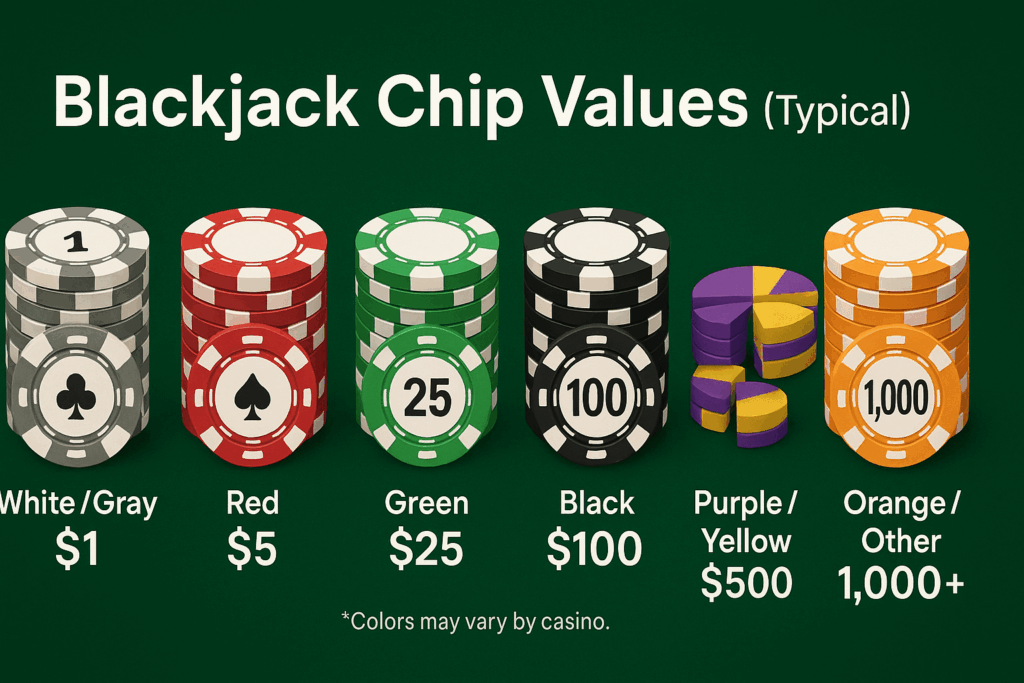
Here’s a general breakdown:
- White or Gray Chips: Typically $1.
- Red Chips: Usually $5.
- Green Chips: Often $25.
- Black Chips: Commonly $100.
- Purple or Yellow Chips: Frequently $500.
- Orange or Other Colors: Can represent $1,000 or higher, depending on the casino.
Player-facing myths I still see (and how I explain them in 10 seconds)
- “All $1 chips are white.” — Not in Vegas; blue/gray show up. AC is stricter; Vegas is flexible by design.
- “Purple equals $500 everywhere.” — Almost—good rule of thumb, not a law. Look for the printed denom.
- “Roulette colors are money.” — They identify the player, not value; cash them to house checks before leaving the table.
- “Heavier chips are higher quality.” — Modern casino chips gravitate to ~10 g for handling; weight alone ≠ quality or authenticity.
Designing or refreshing a set? A quick operator checklist (steal this)
| Decision | Best practice | Why it matters |
|---|---|---|
| Primary palette | Align $5 red / $25 green / $100 black to reduce player error | Matches national expectations; lowers training overhead |
| Secondary/edge spots | High-contrast combos; avoid cross-denom lookalikes | Surveillance reads edges first on stacks; prevents miscalls |
| Size selection | 39 mm core set; 43 mm at $1k+ | Faster visual triage; harder to counterfeit high denoms |
| RFID scope | Tag $500 and up; integrate with cage + pit | Inventory control, bet validation, kill compromised runs |
| Plaque policy | Introduce at $5k–$25k with serials | Serial tracking + visual clarity in high-limit rooms |
| Training collateral | Publish a color/value PDF with region notes | Stops bad assumptions from spreading across brands |
Quick reference: common U.S. cash-game set (paste into training docs)
| Denom | Base color | Typical edge-spot intent |
|---|---|---|
| $1 | White/Blue/Gray | High-contrast pairs for CCTV when racked |
| $5 | Red | Obvious, saturated red; avoid orange-adjacent spots |
| $25 | Green | Distinct from $1 secondary; no mint/teal confusion |
| $100 | Black | Clear inlay numerals; bright edge spots help |
| $500 | Purple | Complex spot recipe; microtext on inlay |
| $1,000 | Orange/Yellow | Consider 43 mm size for differentiation |
| $5,000 | Brown/Burgundy or plaque | Serial or RFID preferred |
| $25,000+ | Plaque (rectangle) | Serial, UV, and strict custody SOP |
Remember: the table above is a house guideline, not law. The law is distinguishability, traceability, and auditable control.
A tiny field test that pays for itself
We ran a low-tech camera legibility test in a basement training room last spring: 720p feed, mixed lighting, six candidate $1/$5/$25 edge-spot patterns. The winning set wasn’t the prettiest—it was the one surveillance could read fastest with stacks half-obscured by hands. Result: 18% fewer “please confirm stack” radio calls week over week after rollout. Not glamorous, but on a busy Saturday you’ll feel it.
Conclusion
Players remember colors. Surveillance reads edges. Compliance cares about what a chip proves. Design your sets, your copy, and your training around those three truths and the rest gets quieter—on the felt and on the radios.
If you’re speccing a new set, revising chip pages, or building internal SOPs, pressure-test your assumptions with NOWG’s free online tools for casinos—rack math, tray audits, and quick surveillance checklists. Faster than ad-hoc spreadsheets, and much harder to break on a busy night.
FAQ About Casino Chip Colors and Values
What do poker chip colors mean?
Poker chip colors indicate the chip’s monetary value. For example, white chips usually represent $1, red chips $5, green chips $25, black chips $100, and purple chips $500. Different colors create a universal language at the table, helping players and dealers instantly recognize bet sizes.
What are standard poker chip colors?
Standard poker chip colors in most casinos are:
White: $1
Red: $5
Green: $25
Black: $100
Purple: $500
Some casinos also use yellow, pink, orange, and blue chips for special denominations.
What is the poker chip color value?
The color value system ensures that players can quickly assess how much money is in play. White ($1), red ($5), green ($25), black ($100), and purple ($500) are the classic poker chip color values in most U.S. casinos.
How much are green chips worth?
Green chips are typically worth $25 in standard casino settings. They’re often used for moderate to high-stakes betting in games like poker, blackjack, and roulette.
How much are red chips worth?
Red chips usually represent a $5 value, serving as the sweet spot between low-stakes white chips and higher-value green and black chips.
How much is a blue poker chip worth?
In many casinos, blue chips are assigned a $10 value. However, this can vary, so it’s always best to check house rules.
What is the black chip casino value?
A black chip is almost universally valued at $100 across U.S. casinos. Slamming a stack of black chips on the table means you’re playing serious stakes.
What do yellow chips mean in a casino?
Yellow chips in casinos often represent $1,000. However, yellow chips are less common and sometimes swapped with gray or orange chips for the same denomination depending on the casino.
What are yellow casino chips worth?
In many cases, yellow chips are valued at $1,000, but this can vary. Always double-check the chip denominations at your specific casino before betting.
What is the pink chip casino value?
Pink chips are often valued at $250, especially in higher-stakes games or tournament settings.
What are typical poker chip values?
Typical poker chip values include:
White: $1
Red: $5
Green: $25
Black: $100
Purple: $500
Some sets expand into yellow, blue, orange, brown, and pink chips for larger stakes or custom home games.
What are the standard casino chip colors?
The standard casino chip colors align closely with poker:
White ($1)
Red ($5)
Green ($25)
Black ($100)
Purple ($500)
Yellow or Gray ($1,000)
This creates consistency for players moving between tables and casinos.
What is the value of poker chips by color?
In basic terms:
White: $1
Red: $5
Blue: $10
Green: $25
Black: $100
Purple: $500
Yellow/Gray: $1,000
These colors help regulate the flow of betting in games like poker, blackjack, and baccarat.
Are poker chip colors different in Vegas casinos?
Yes, but only slightly. In Las Vegas, casino chip values by color typically follow the standard U.S. setup. However, specialty chips, promotional events, or high-stakes rooms may introduce additional colors like pink ($250) or orange ($1,000).
How much are poker chips worth?
The worth of a poker chip depends on its color, ranging from $1 white chips to $5,000 brown or burgundy chips in high-stakes environments.
What is the value of blackjack chips?
In blackjack:
Red chips = $5
Green chips = $25
Black chips = $100
are the most common. Casinos keep these chip colors consistent for fast, smooth gameplay.
What are gambling chips used for?
Gambling chips replace cash at tables for security, speed, and standardization. Their colors and denominations help players make quicker decisions without fumbling for bills.
How do casino chip values vary by location?
In places like Macau or Monte Carlo, chip values skyrocket. A yellow chip might represent tens of thousands of dollars, reflecting the ultra-high stakes common in Asian and European casinos. Always check before sitting down!

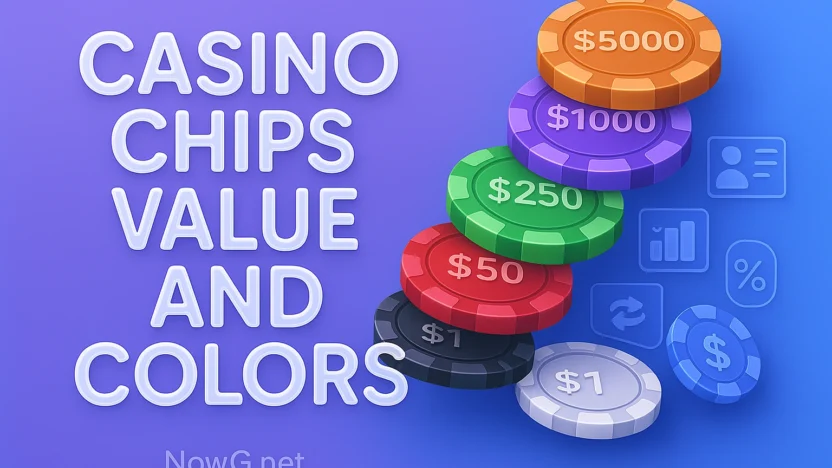


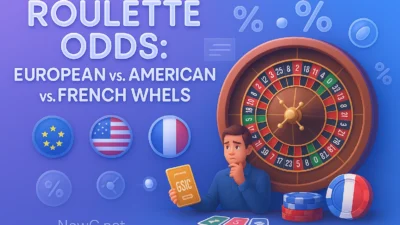
[…] – Casino cashier where chips turn back into […]
I really enjoyed this guide! The breakdown of the different colors and values of casino chips was super helpful. It’s great to finally understand how the chip values work in various games. Thanks for providing such clear information!
Great guide on casino chip values and colors! I found the explanations really helpful, especially for someone new to the casino scene. It’s fascinating how much thought goes into the design and value of each chip. Thanks for sharing!
Great guide! I never realized how much the color of the chips can indicate their value in different casinos. This will definitely help me navigate the tables better during my next visit. Thanks for the info!
Great breakdown of casino chip values and colors! I always found it confusing, but your guide makes it much clearer. I appreciate the detailed explanations and visuals. Looking forward to trying out some tips on managing my chip stash next time at the tables!
Great guide! I never realized how much the colors and values of casino chips varied between different games and casinos. This is super helpful for someone new to the casino scene like me. Thanks for breaking it all down!
Great post! I had no idea about the significance of different chip colors and their values in casinos. The detailed explanations really helped me understand how to navigate table games better. Thanks for sharing this informative guide!
Great guide! I never realized how much the color of casino chips could vary in value. This will definitely help me make better choices when I visit the casino next time. Thanks for breaking it all down so clearly!